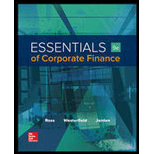
Concept explainers
To calculate: The rate of crossover for two projects and sketch the NPV profile.
Introduction:
The
Answer to Problem 11QP
The crossover rate for the two projects is 7.62%. The NPV profiles shows that both projects have a higher NPV for the rate of discount below 7.62% and have a lower NPV for the rate above 7.62%.
Explanation of Solution
Given information:
The details of two projects are provided. The cash flows of project X for year 1, year 2, and year 3, are $13,100, $9,480, and $7,890 respectively. The initial investment is $23,400. The project Y cash flows for 4 years are $9,200, $10,620, $11,180 respectively and the initial investment is $23,400.
Note:
- NPV is the difference between the present values of the cash inflows and the
present value of the cash outflows. - The IRR is the rate of interest, which makes the project’s NPV equals zero. Hence, using the available information, assume that NPV is equal to zero and form an equation to compute the IRR.
Equation of NPV to compute IRR assuming that NPV is equal to zero:
Compute IRR for project X using a spreadsheet:
Step 1:

- Type the equation of NPV in H6 in the spreadsheet and consider the IRR value as H7.
Step 2:

- Assume the IRR value as 10%.
Step 3:

- In the spreadsheet, go to data and select the What-if analysis
- In What-if analysis, select Goal Seek.
- In “Set cell”, select H6 (the formula).
- The “To value” is considered as 0 (the assumption value for NPV).
- The H7 cell is selected for “By changing cell”.
Step 4:

- Following the previous step, click OK in the Goal Seek Status. The Goal Seek Status appears with the IRR value.
Step 5:
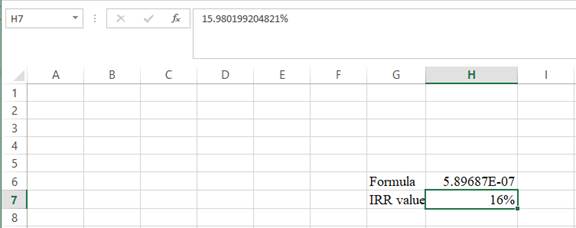
- The value appears to be 15.980199204821%.
Hence, the IRRvalue is 15.98%.
Equation of NPV to compute IRR assuming that NPV is equal to zero:
Compute IRR for project Y using a spreadsheet:
Step 1:

- Type the equation of NPV in H6 in the spreadsheet and consider the IRR value as H7.
Step 2:

- Assume the IRR value as 10%.
Step 3:
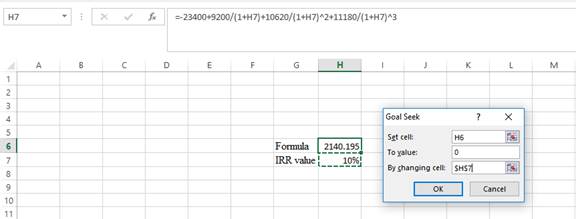
- In the spreadsheet, go to data and select the What-if analysis.
- In What-if analysis, select Goal Seek.
- In “Set cell”, select H6 (the formula).
- The “To value” is considered as 0 (the assumption value for NPV).
- The H7 cell is selected for “By changing cell”.
Step 4:

- Following the previous step, click OK in the Goal Seek Status. The Goal Seek Status appears with the IRRvalue.
Step 5:
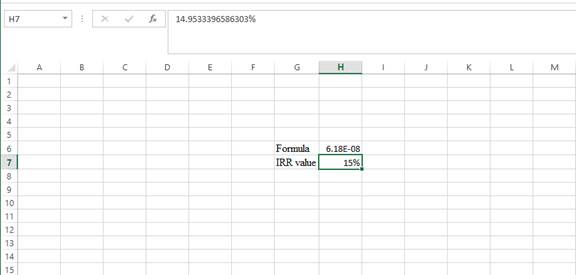
- The value appears to be 14.953339658603%.
Hence, the IRRvalue is 14.95%.
Formula to compute the crossover rate:
Equation of crossover rate to compute R:
Where,
“R” denotes the crossover rate.
Compute R using a spreadsheet:
Step 1:
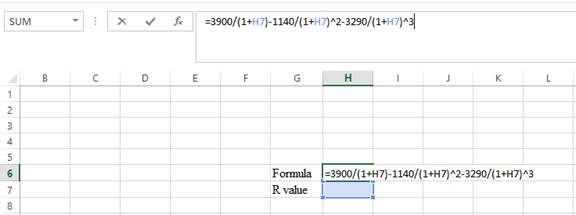
- Type the equation of NPV in H6 in the spreadsheet and consider the IRR value as H7.
Step 2:
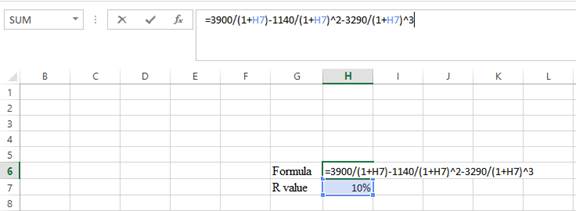
- Assume the IRR value as 10%.
Step 3:
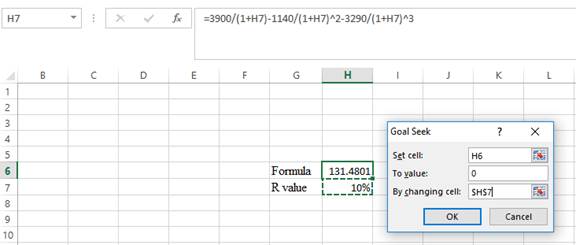
- In the spreadsheet, go to data and select the What-if analysis.
- In What-if analysis, select Goal Seek.
- In “Set cell”, select H6 (the formula).
- The “To value” is considered as 0 (the assumption value for NPV).
- The H7 cell is selected for “By changing cell”.
Step 4:
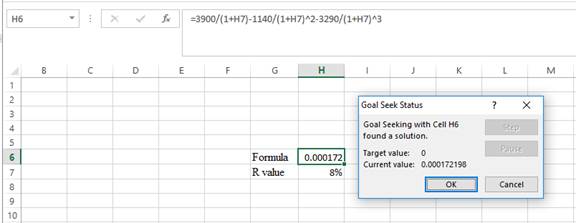
- Following the previous step, click OK in the Goal Seek Status. The Goal Seek Status appears with the IRRvalue.
Step 5:
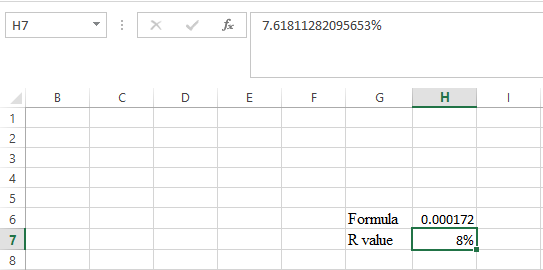
- The value appears to be 7.61811282095653%.
Hence, the R-value is 7.62%.
Formula to calculate the NPV:
Note: As the discount rate is over a range of 0% to 25%, calculate NPV for 0%, 5%, 10%, 15%, 20%, and 25%.
Compute the NPV with the discount rate of 0% for project X:
Compute the NPV with the discount rate of 0% for project Y:
Hence, the NPV for project X and Y at 0% are $7,070 and $7,600 respectively.
Compute the NPV with the discount rate of 5% for project X:
Compute the NPV with the discount rate of 5% for project Y:
Hence, the NPV for project X and Y at 5% are $4,490.51 and $4,652.26 respectively.
Compute the NPV with the discount rate of 10% for project X:
Compute the NPV with the discount rate of 10% for project Y:
Hence, the NPV for project X and Y at 10% are $2,271.68 and $2,140.20 respectively.
Compute the NPV with the discount rate of 15% for project X:
Compute the NPV with the discount rate of 15% for project Y:
Hence, the NPV for project X and Y at 15% are $347.35 and -$18.72 respectively.
Compute the NPV with the discount rate of 20% for project X:
Compute the NPV with the discount rate of 20% for project Y:
Hence, the NPV for project X and Y at 20% are -$1,334.03 and -$1,888.43 respectively.
Compute the NPV with the discount rate of 25% for project X:
Compute the NPV with the discount rate of 25% for project Y:
Hence, the NPV for project X and Y at 25% are -$2,813.12 and -$3,519.04 respectively.
NPV profile:
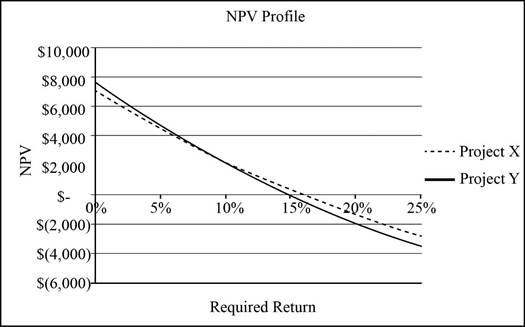
Want to see more full solutions like this?
Chapter 8 Solutions
ESSENTIALS CORPORATE FINANCE + CNCT A.
- High Hand Nursery has total assests of $900,000, current liabilities of $202,000, and long-term liabilities of $104,000. There is $90,000 in preferred stock outstanding. Twenty thousand shares of common stock have been issued. a. Compute book value (net worth) per share. b. If there is $40,000 in earnings available to common stockholders for dividends, and the firm's stock has a P/E of 22 times earnings per share, what is the current price of the stock? c. What is the ratio of market value per share to book value per share?arrow_forwardNeed the WACC % WACC and Optimal Capital Structure F. Pierce Products Inc. is considering changing its capital structure. F. Pierce currently has no debt and no preferred stock, but it would like to add some debt to take advantage of the tax shield. Its investment banker has indicated that the pre-tax cost of debt under various possible capital structures would be as follows: Market Debt-to-Value Ratio (wd) Market Equity-to-Value Ratio (ws) Market Debt-toEquity Ratio (D/S) Before-Tax Cost ofDebt (rd) 0.0 1.0 0.00 6.0 % 0.10 0.90 0.1111 6.4 0.20 0.80 0.2500 7.0 0.30 0.70 0.4286 8.2 0.40 0.60 0.6667 10.0 F. Pierce uses the CAPM to estimate its cost of common equity, rs, and at the time of the analaysis the risk-free rate is 5%, the market risk premium is 7%, and the company's tax rate is 25%. F. Pierce estimates that its beta now (which is "unlevered" because it currently has no debt) is 1.4. Based on this information, what…arrow_forwardNed's Co. has an average collection period of 45 days and an operating cycle of 130 days. It has a policy of keeping at least $10 on hand as a minimum cash balance, and has a beginning cash balance for the first quarter of $20. Beginning receivables for the quarter amount to $35. Sales for the first and second quarters are expected to be $110 and $125, respectively, while purchases amount to 80% of the next quarter's forecast sales. The accounts payable period is 90 days. What are the cash disbursements for the first quarter? Question 4 options: $92 $88 $76 $100 $110arrow_forward
- Liberal credit terms for customers is associated with a restrictive short-term financial policy. Question 3 options: True Falsearrow_forwardAn accounts payable period decrease would increase the length of a firm's cash cycle. Consider each in isolation. Question 6 options: True Falsearrow_forwardWhich of the following is the best definition of cash budget? Question 10 options: Costs that rise with increases in the level of investment in current assets. A forecast of cash receipts and disbursements for the next planning period. A secured short-term loan that involves either the assignment or factoring of the receivable. The time between sale of inventory and collection of the receivable. The time between receipt of inventory and payment for it.arrow_forward
- Short-term financial decisions are typically defined to include cash inflows and outflows that occur within __ year(s) or less. Question 9 options: Four Two Three Five Onearrow_forwardA national firm has sales of $575,000 and cost of goods sold of $368,000. At the beginning of the year, the inventory was $42,000. At the end of the year, the inventory balance was $45,000. What is the inventory turnover rate? Question 8 options: 8.46 times 13.22 times 43.14 times 12.78 times 28.56 timesarrow_forwardThe formula (Cash cycle + accounts payable period) correctly defines the operating cycle. Question 7 options: False Truearrow_forward
- An accounts payable period decrease would increase the length of a firm's cash cycle. Consider each in isolation. Question 6 options: True Falsearrow_forwardWhich of the following issues is/are NOT considered a part of short-term finance? Question 5 options: The amount of credit that should be extended to customers The firm determining whether to issue commercial paper or obtain a bank loan The amount of the firms current income that should be paid out as dividends The amount the firm should borrow short-term A reasonable level of cash for the firm to maintainarrow_forwardLiberal credit terms for customers is associated with a restrictive short-term financial policy. Question 3 options: True Falsearrow_forward
 Essentials Of InvestmentsFinanceISBN:9781260013924Author:Bodie, Zvi, Kane, Alex, MARCUS, Alan J.Publisher:Mcgraw-hill Education,
Essentials Of InvestmentsFinanceISBN:9781260013924Author:Bodie, Zvi, Kane, Alex, MARCUS, Alan J.Publisher:Mcgraw-hill Education,

 Foundations Of FinanceFinanceISBN:9780134897264Author:KEOWN, Arthur J., Martin, John D., PETTY, J. WilliamPublisher:Pearson,
Foundations Of FinanceFinanceISBN:9780134897264Author:KEOWN, Arthur J., Martin, John D., PETTY, J. WilliamPublisher:Pearson, Fundamentals of Financial Management (MindTap Cou...FinanceISBN:9781337395250Author:Eugene F. Brigham, Joel F. HoustonPublisher:Cengage Learning
Fundamentals of Financial Management (MindTap Cou...FinanceISBN:9781337395250Author:Eugene F. Brigham, Joel F. HoustonPublisher:Cengage Learning Corporate Finance (The Mcgraw-hill/Irwin Series i...FinanceISBN:9780077861759Author:Stephen A. Ross Franco Modigliani Professor of Financial Economics Professor, Randolph W Westerfield Robert R. Dockson Deans Chair in Bus. Admin., Jeffrey Jaffe, Bradford D Jordan ProfessorPublisher:McGraw-Hill Education
Corporate Finance (The Mcgraw-hill/Irwin Series i...FinanceISBN:9780077861759Author:Stephen A. Ross Franco Modigliani Professor of Financial Economics Professor, Randolph W Westerfield Robert R. Dockson Deans Chair in Bus. Admin., Jeffrey Jaffe, Bradford D Jordan ProfessorPublisher:McGraw-Hill Education





